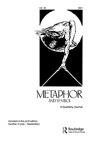空间隐喻中的权力、性别和个体差异:感知刻板印象和语言统计的作用
IF 3.3
3区 文学
0 LANGUAGE & LINGUISTICS
引用次数: 9
摘要
摘要英语使用者使用垂直语言来谈论权力,例如当谈到人们“处于社会等级的底层”或“上升到高层”时。实验研究表明,与较低的空间职位相比,人们会自动将较高的空间职位与更强大的社会群体联系起来,如医生和军队将领,这些组织与护士和士兵等相对较弱的团体有关联。然而,权力作为一个社会层面也与性别有关。在这里,通过反应时间研究和语料库研究,我们发现,表现出更大性别不对称的职业,如医生/护士,表现出更强的垂直关联。此外,我们发现,人们对权力的垂直隐喻的感知取决于他们自己的性别,男性参与者比女性参与者具有更强的垂直偏见,我们认为这是因为男性更倾向于用身体的角度思考权力,并将其与身体支配联系起来。我们的研究结果为隐喻理解的个体差异提供了明确的证据,从而从经验上证明了不同的人对同一个隐喻的理解不同。本文章由计算机程序翻译,如有差异,请以英文原文为准。
Power, Gender, and Individual Differences in Spatial Metaphor: The Role of Perceptual Stereotypes and Language Statistics
ABSTRACT English speakers use vertical language to talk about power, such as when speaking of people being “at the bottom of the social hierarchy” or “rising to the top.” Experimental research has shown that people automatically associate higher spatial positions with more powerful social groups, such as doctors and army generals, compared to lower spatial positions, which are associated with relatively less powerful groups, such as nurses and soldiers. However, power as a social dimension is also associated with gender. Here, by means of a reaction-time study and a corpus study, we show that professions that display greater gender asymmetries, such as doctor/nurse, exhibit stronger vertical associations. Moreover, we show that people’s perception of vertical metaphors for power depends on their own gender, with male participants having stronger vertical biases than female participants, which we propose is due to the fact that men are more prone to thinking about power in bodily terms, and to associate it with physical dominance. Our results provide clear evidence for individual differences in metaphor comprehension, thus demonstrating empirically that the same metaphor is understood differently by different people.
求助全文
通过发布文献求助,成功后即可免费获取论文全文。
去求助
来源期刊

Metaphor and Symbol
Multiple-
CiteScore
2.90
自引率
0.00%
发文量
23
期刊介绍:
Metaphor and Symbol: A Quarterly Journal is an innovative, multidisciplinary journal dedicated to the study of metaphor and other figurative devices in language (e.g., metonymy, irony) and other expressive forms (e.g., gesture and bodily actions, artworks, music, multimodal media). The journal is interested in original, empirical, and theoretical research that incorporates psychological experimental studies, linguistic and corpus linguistic studies, cross-cultural/linguistic comparisons, computational modeling, philosophical analyzes, and literary/artistic interpretations. A common theme connecting published work in the journal is the examination of the interface of figurative language and expression with cognitive, bodily, and cultural experience; hence, the journal''s international editorial board is composed of scholars and experts in the fields of psychology, linguistics, philosophy, computer science, literature, and media studies.
 求助内容:
求助内容: 应助结果提醒方式:
应助结果提醒方式:


